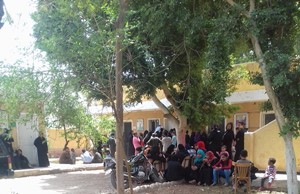
9 May 2018 – The WHO country office Egypt, in collaboration with the Ministry of Health and Population’s leprosy control programme, conducted a 10-day active screening campaign in Esna from 15 to 25 April 2018 to identify people with leprosy and provide them with treatment. Esna, a district in Luxor, has one of the highest prevalence rates of leprosy in Upper Egypt.
Twenty seven villages were selected for inclusion in the campaign based on the number of new cases registered in each village in the previous 10 years and consistency of reporting. All index cases and their close contacts were examined and members of the community were screened for leprosy and other dermatological diseases. Suspected cases were referred for examination and treatment.
Active screening is essential for the early diagnosis of leprosy, which is curable, and treatment in the early stages can prevent disability. In Egypt, treatment is provided free of charge which encourages patients to seek treatment when diagnosed. The treatment schedule lasts for one year.
Since 1994, Egypt has met WHO’s global leprosy elimination goal of reducing prevalence to less than 1 per 10 000 population; however, there are still governorates in which prevalence rates are higher. Sustained efforts since 2004 have reduced the number of these governorates.
Almost 60% of new cases detected each year in Egypt originate from only 6 governorates, mainly located in the south of the country. These governorates have not yet reached the national elimination goal. Approximately 6% of new cases reported annually are children under 15 years of age.
Leprosy is a chronic infectious disease caused by Mycobacterium leprae. The disease mainly affects the skin, peripheral nerves, upper respiratory tract, and the eyes.


